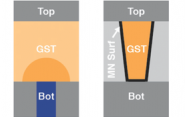A Promising Computer Technology Advances With Yale-IBM Collaboration

A collaboration between the lab of Judy Cha, the Carol and Douglas Melamed Assistant Professor of Mechanical Engineering & Materials Science, and IBM’s Watson Research Center could help make a potentially revolutionary technology more viable for manufacturing.
Phase-change memory (PCM) devices have in recent years emerged as a game-changing alternative to computer random-access memory. Using heat to transform the states of material from amorphous to crystalline, PCM chips are fast, use much less power and have the potential to scale down to smaller chips – allowing the trajectory for smaller, more powerful computing to continue. However, manufacturing PCM devices on a large scale with consistent quality and long endurance has been a challenge.
 “Everybody’s trying to figure that out, and we want to understand the phase change behavior precisely,” said Yujun Xie, a PhD candidate in Cha’s lab and lead author of the study. “That’s one of the biggest challenges for phase-change memory.”
“Everybody’s trying to figure that out, and we want to understand the phase change behavior precisely,” said Yujun Xie, a PhD candidate in Cha’s lab and lead author of the study. “That’s one of the biggest challenges for phase-change memory.”
The work of the Yale-IBM research team could help clear this hurdle. Using in situ transmission electron microscopy (TEM) at the Yale Institute for Nanoscience and Quantum Engineering (YINQE), they observed the device’s phase change and how it “self-heals” voids - that is, empty spaces left by the depletion of materials caused by chemical segregation. These kinds of nanoscale voids have caused problems for previous PCM devices. Their results on self-healing of voids are published in Advanced Materials.
The standard PCM device has what’s known as a mushroom structure, while the Yale-IBM team used a confined PCM structure with a metallic lining to make it more robust. “The metallic liner protects the material and reduces the resistance drift of the PCM, improving the whole performance,” Xie said.
By observing the phase-change process through TEM, the researchers saw how the PCM device’s self-healing properties come from a combination of the device’s structure and the metallic lining, which allow it to control the phase-change of the material.
Wanki Kim, an IBM researcher who worked on the project, said the next step is possibly to develop a bipolar operation to switch the direction of voltage, which can control the chemical segregation. In normal operation mode, the direction of voltage bias is always the same. This next step could prolong the device lifetime even further.

